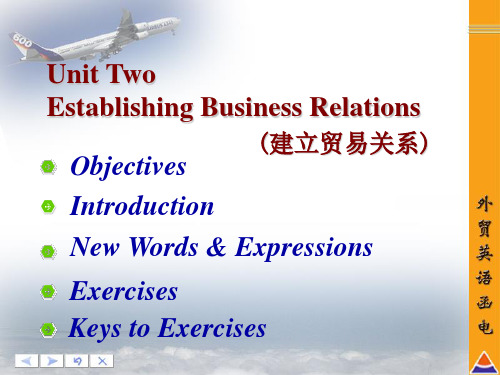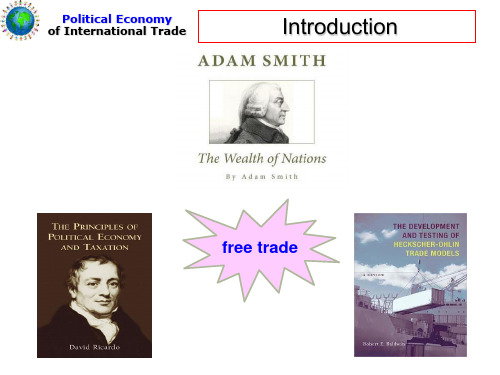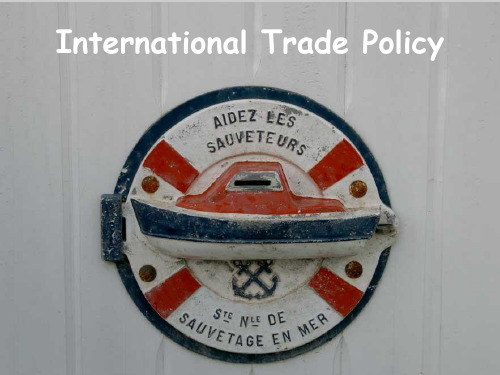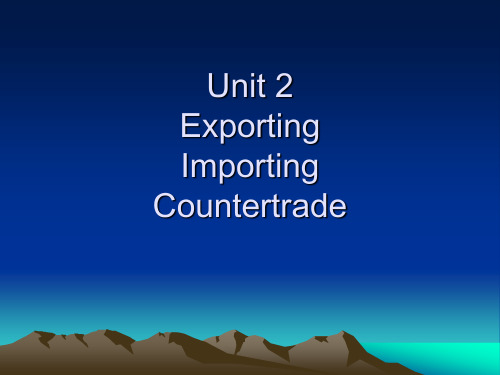国际商务英语课文电子版lesson (2)
- 格式:doc
- 大小:46.50 KB
- 文档页数:7



Unit 21.The manufacturer, therefore, has to find the balance between designing a separate car foreach market – which would be exorbitantly costly – and designing one car for all markets.因此,制造商就必须在为每个市场设计一辆不同的车(这当然需要高昂的费用)和为所有市场设计同一款车之间寻求平衡。
2.Such opportunities are not normally available to a company that operates only in onecountry or is only just entering a new country.只在一个国家经营或只进入一个新的国家的公司通常得不到这样的机会。
3.The advent of the Internet and Intranets has the potential to accelerate the process ofmining all markets for relevant information and for features that can be included in new products.互联网和局域网的来临有可能加快发掘所有的市场找到相关信息和能被用到新产品中的特征的过程。
4.The laboratories co-ordinates their efforts by looking at the possibilities of melding productideas arising from different countries.这些实验室通力协作寻求把产生于不同国家的关于产品的想法加以整合的可能性。
5.The product itself may have been developed with reference to observations of present andpotential customers rather than conventional market research.产品本身的开发也许参考了对现有或潜在客户的观察,而不是常规的市场研究。

自考国际商务英语(05844)教材英文课文(2005年版)电子版LESSON 1 International BusinessTHE STRUCTURE OF THE ARTICLE:了解国际商务与内商务的区别,熟悉贸易、投资及其他际商务活动的含义、特点、运作方式等。
Major difference between international business and domestic business(A. differences in legal systemB. differences in currenciesC. differences in cultural backgroundD. differences in natural and economic conditionsMajor types of international business.A. tradea. commodity tradeb. service tradeB. investmenta. foreign direct investmentb. portfolio investmentC. other typesa. licensing and franchisingb. management contract and contract manufacturingc. turnkey project and BOTTEXT:International business refers to transaction between parties from different countries. Sometimes business across the borders of different customs areas of the same country is also regarded as import and export, such as business between Hong Kong and Taiwan.International business involves more factors and thus is more complicated than domestic business. The followings are some major differences between the two:1(The countries involved often have different legal systems, and one or more parties will have to adjust themselves to operate in compliance with the foreign law.2(Different counties usually use different currencies and theparties concerned will have to decide which currency to use and do everything necessary as regards conversion etc. Uncertainties and even risks are often involved in the use of a foreign currency.3(Cultural differences including language, customs, traditions, religion, value, behavior etc. Often constitute challenges and even traps for people engaged in international business.4(Countries vary in natural and economic conditions and may have different policies towards foreign trade and investment, making international business more complex than domestic business.With the development of economic globalisation, few people or companies can completely stay away from international business. Someknowledge in this respect is necessary both for the benefit of enterprises and personal advancement. International business first took the form of commodity trade, i. e. exporting and importing goods produced or manufactured in one countryfor consumption or resale in another. This form of trade is also referred to as visible trade.Later a different kind of trade in the form of transportation, communication, banking, insurance, consulting, information etc. gradually became more and more important. This type of trade is called invisible trade(无形贸易). Today, the contribution of service industries of thedeveloped countries constitutes over 60 ,of their gross domestic products and account for anincreasing proportion of world trade.Another important form of international business is supplyingcapital by residents of one country to another, known as international investment. Such investments can be classified into two categories. The first kind of investments, foreign direct investments or FDI for shortis made for returns through controlling the enterprises or assets invested in in a host country. The host country is a foreign country where the investor operates, while the country where the headquarters of the investor is located is called the home country. The second kind of investment, portfolio investment(证券投资) refers to purchases offoreign financial assets for a purpose other than controlling. Suchfinancial assets may be stocks , bonds or certificates of deposit. Stocks are also called capital stocks or bonds. Bonds are papers issued by a government or a firm with promise to pay back the money lent or invested together with interest. The maturity period of a bond is at least one year, often longer, for example five, or even ten years. Certificates of deposit generally involve large amounts, say 25 thousand US dollars.Besides trade and investment, international licensing andfranchising are sometimes taken as a means of entering a foreign market. In licensing, a firm leases the right to use its intellectual property (知识产权)to a firm in another country. Such intellectual property may be trademarks (商标), brand names (品牌), patents (专利), copyrights (版权) or technology. Firms choose licensingbecause they do not have to make cash payments to start business, and can simply receive income in the form of royalty. Besides, they can benefit from locational advantages of foreign operation without any obligations in ownership or management. The use of licensing is particularly encouraged by high customs duty and non-tariff barriers on the part of the host country. However it is not advisable to use licensing in countries with weak intellectual property protection since the licensor may have difficulty in enforcing licensing agreement.Franchising can be regarded as a special form of licensing. Under franchising, a firm, called the franchisee, is allowed to operate in thename of another, called the franchiser who provides the former with trademarks, brand names, logos, and operating techniques for royalty. In comparison with the relation between the licenser and the licensee, the franchiser has more control over and provides more support for the franchisee.The franchiser can develop internationally and gain access to useful information about the local market with little risk and cost, and the franchisee can easily get into a business with established products or services. Franchising is fairly popular especially in hotel and restaurant business. Other forms for participating in international business are management contract, contract manufacturing, and turnkey project.Under a management contract, one company offers managerial or other specialized services to another within a particular period for a flat payment or a percentage of the relevant business volume. Sometimes bonuses based on profitability or sales growth are also specialized in management contracts. Government policies often have a lot to do with management contracts. When a government forbids foreign ownership in certain industries it considers to be of strategic importance but lacks the expertise for operation, management contracts may be a practical choiceenabling a foreign company to operate in the industry without owning the assets.By contract manufacturing, a firm can concentrate on their strongest part in the value chain, e. g. marketing, while contracting with foreign companies for the manufacture of their products. Such firms can reduce the amount of their resources devoted to manufacture and benefit from location advantages from production in host countries. However, loss of control over the production process may give rise to problems in respect of quality and time of delivery.For an international turnkey project, a firm signs a contract with a foreign purchaser and undertakes all the designing, contracting and facility equipping before handing it over to the latter upon completion. Such projects are often large and complex and take a long period to complete. Payment for a turnkey project may be made at fixed total price or on a cost plus basis. The latter way of payment shifts the burden of possible additional cost over the original budget onto the purchaser.BOT is a popular variant of the turnkey project where B stands for build, O for operate and T for transfer. For a BOT project, a firm operates a facility for a period of time after building it up before finally transferring it to a foreign company. Making profit from operating the project for a period is the major difference between BOT and the common turnkey project. Needless to say, the contractor has to bear the financial and other risks that may occur in the period of operation.2 income level and the world market——————————————————————————————————————————————掌握国内生产总值,国民生产总值,人均收入等概念的含义。


Unit 2 Planning an E-businessText A Elements of a Good Business Plan一个好的商业计划要素Business plans will vary from company reflecting their different needs. For example,an established business looking at adding an online componentwill be able to focus on integration between the physical store and the online store. A pure player – a business operating solely on the internet-will use its business plans to demonstrate its market analysis and seek funding. Regardless of use, good business plans generally consist of an executive summary, a market analysis, a description of the company and its management, a marketing and sales strategy, and a description of products and services offered. If necessary, business plans can include funding requests and necessary financial information.商业计划将不同的公司反映他们不同的需求。
例如,一个既定的业务,增加一个在线组件,将能够专注于实体店和网上商店之间的整合。
In assessing (evaluate) the potential of a market, people often look at its income level since it provides clues (ideas) about the purchasing power of its residents. The concepts national income and national product have roughly the same value and can be used interchangeably if our interest is in their sum total which is measured as the market value of the total output of goods and services of an economy in a given period, usually a year. The difference is only in their emphasis. The former stresses the income generated (produced) by turning out the products while the latter, the value of the productsthemselves. GNP (Gross National Product) and GDP (Gross Domestic Product) are two important concepts used to indicate a country’s total income.GNP refers to the market value of goods and services produced by the property and labor owned by the residents of an economy. This term was used by most government before the 1990s. GDP measures the market value of all goods and services produced within the geographic area of an economy. It has been preferred by most countries since the 1990s.The difference between GNP and GDP is that the former focuses on ownership of the factors of production while the latter concentrates on the place where production takes place. For example, the dividend returned by the subsidiary of Microsoft in China is included in the US GNP but not in its GDP. And the production of the same subsidiary is included in China’s GDP but not in its GNP. The difference between GNP and GDP can be ignored since it is very small in most cases. People can use whichever term that ismore easily available and they can compare a country’s GNP and another country’s GDP without worrying that the result would be terribly distorted. For instance, in 1996, the US GNP was 7,637.7 billion US Dollars and its GDP was 7,636 billion US Dollar, a difference of only 0.02%. And in 1996, China’s GNP was 8,042.28 billion yuan Renminbi and its GDP was 8,191.09 billion yuan, with a difference of 1. 8%, still insignificant though larger than the US figure.In assessing the potential of a country as a market, people often look at per capita income. Similar to the case of national income and national product, per capita income and per capita GDP do not have much difference. So let’s use per capita GDP to illustrate an economy’s income level. It is calculated by dividing its total GDP by its population. Total GDP indicates the overall size of an economy, which is important in market assessment for durable equipment or bulk goods such as grain, steel, or cement. Per capital GDP reveals (shows) the average income level of consumers, which is important when marketing consumer durables. For example, China has a large GDP of roughly USD 1. 4 trillion in 2003, being the seventh largest economy in the world. If adjusted by PPP, the figure would probably be as large as USD 6. 4 trillion, accounting for 12% of the world’s total and ranking the second only after the USA. So china is not only a newly emerging producer but also a newly emerging market. However its per capital GDP is still fairly low, just a bit over USD 1 100. Though $1 000 per capital income is believed by experts to be level at whichconsumerism begins to emerge (form), the Chinese figure is still rather low, ranking only the 111th in the world. In contrast, Singapore has a GDP of roughly a bit over $100 billion, but a per capital income as high as $32 810. Obviously China and Singapore represent two different kinds of market.Business people are also concerned about the income distribution of a market, i. e. the proportions of its rich, middle income and poor people. Producers of quality electrical appliances such as color TVs are interested in the size of a country’s middle class, while manufacturers of expensive cars such as Rolls-Royces may want to know the number of its millionaires.Countries of the world are divided by the World Bank into three categories of high-income, middle-income and low-income economies. Those enjoying annual per capital income of $9 386 and above are classified as high-income countries. This group comprises(is made up of)three types of countries. The first type includes most members of the Organization for Economic Cooperation and Development (OECD). The second type are rich oil producing countries of the Middle East such as Kuwait, Saudi Arabia, and the United Arab Emirates. The third type consists of small-industrialized countries or regions such as Israel, Singapore, Hong Kong and Taiwan. High-income countries often have good infrastructure, high purchasing power, advanced technology, efficient management, and favorable environment for trade and investment. They offer prime markets for expensive consumer goods and are both attractive sources and destinations of investment.Countries with annual per capita income below $9,386 but above $765 are regarded as middle-income countries. Included in this category are most East European countries and most members of the Commonwealth of Independent States, six OECD members that are not up to the level of high income countries, quite a number of Latin American countries and some comparatively developed countries in Asia, such as Indonesia, Malaysia, the Philippines, and Thailand. Among the African countries, South Africa and oil-producing Libya, Nigeria and Algeria belong to this category. China with a per capita income of over $1100 is a middle-income country though it was a low income country just a few years ago.Lower income countries are those that have per capita incomes of only $765 or even less. Most African countries, some Asian countries and a few Latin American countries are included in this group. These countries usually have poor infrastructure, low consumer demand and unfavorable business environment. But that does not mean they should be neglected in international business activities, because they constitute markets for lower-priced staple goods, provide cheap labor and are often rich in resources. What is more important, market is something to be developed. Once tapped, the business potential of these countries will one day become real business opportunities.The term Triad refers to the three richest regions of the world the United States, the European Union and Japan that offer the most important business opportunities. Any international enterprise must bear Triad in mind if they wantto be successful in the increasingly competitive world market.With a per capita income of about $30,000, the United States is the richest country in the Western Hemisphere. Though the per capita income of a few small countries like Switzerland is much higher than that of the United States, the overall size of the U.S economy of about $10 trillion GDP, roughly a quarter of the world total, coupled with its political stability puts the country on a unique position in the world. It accounts for about 15% of world visible and invisible trade. The U.S. dollar is the invoicing currency for about half of the international transactions and is an important component of foreign currency reserves of the world. The United States has been regarded by many people as a safe haven who tend to keep their wealth in US dollar when they lose confidence in the value of their own currency. And for many years the country remained the largest recipient (destination) of foreign investment. Over 160 of the world’s 500 largest corporations have their headquarters in the United States including 24 of the top 100. The country’s large middle class make it an attractive market for enterprises all around the globe.The second component of Triad is Western Europe that mainly refers to the European Union. With an average per capita income of over $20,000, all the members before its eastward expansion are classified as high income countries. Its total GDP of over 10 trillion US dollars is the largest, larger than that of the United States. Germany, France, Britain and Italy are the 4 richest, most populous and developed countries of EU. These countries are each anattractive market, and combined they constitute the largest rich market in the world. In the present intensely competing world, it is necessary and beneficial to diversify our major markets, and the importance of EU as one leg of Triad cannot be overstressed.Japan is the third component of Triad and the second largest economy of the world. It is an important supplier of high-tech products and a major importer of raw materials. While exports have greatly spur red (stimulated) Japan’s development, trade only accounts for a relatively small proportion of its GDP. Japan remained a target of criticism for engaging in unfair trade practices. The large trade surplus has enabled it to invest heavily abroad and for years it has been the largest creditor country (debtor country) of the world. With mutually complementary economy, Japan and China are major trade partners, and the two countries are close neighbours separated only by a strip of water. Sino-Japanese business relations are therefore of great importance to both countries.Some people extend the scope of Triad to include Canada and name the broadened grouping Quad.With the world’s second largest territory, Canada is rich in natural resources and its export accounts for nearly 40% of its GDP. The percentage is much higher than those of other members of t he Group of Seven and suffices (be enough) to show the importance of trade to the country. Sharing a very long common border along which most of the Canadian people live, Canada and the United States, with their respective rich market, enjoy thelargest single bilateral trade in the world.So far as China is concerned, other markets we should pay particular attention to are those around us: the Four Tigers, the ASEAN countries, Russia, India, and a bit farther away Australia. These countries or regions either have rich consumers and offer good business opportunities or are developing fast with very promising market potential. (Bric – Brazil, Russia, India, China) And their geographical proximity to China is a great advantage for us in developing business relations with them. Despite the above observations, it does not mean we can neglect other markets. Different markets offer different opportunities and it is not a good idea to tie one’s business to only a few markets. The best policy is to develop business opportunities wherever advantageous while keeping in mind the key markets.。